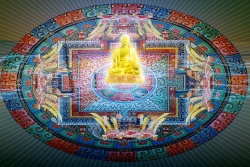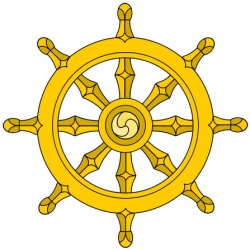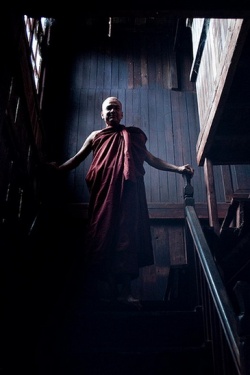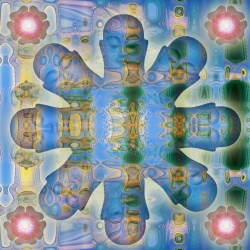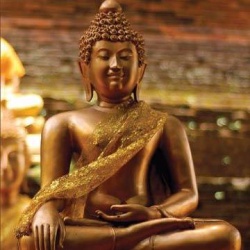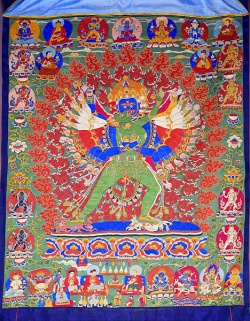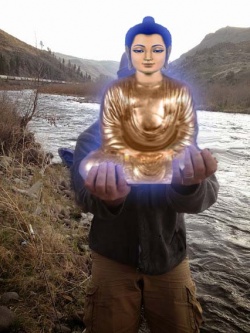Abhidhamma Teachings on the Manifold Planes of Existence
The 31 Planes of Existence
| Plane | ||
|---|---|---|
| Immaterial Sphere Plane 4 | 84,000 G.A 60,000 G.A. | |
| Fine-material Sphere Plane 16 | 5th Jhana Plane 27. Highest Pure Abode (Pure Abodes 23 - 27) 26. Clear-sighted Pure Abode
|
16,000 G.A. 8,000 G.A. |
| 4th Jhana Plane 20. Steady Aura |
64 G.A. 32 G.A. | |
2nd & 3rd Jhana Planes 17. Radiant Lustre
|
8 G.A. 4 G.A. | |
1st Jhana Plane 14. Maha Brahma |
1 I.A. 1/2 I.A. | |
| Sense-Sphere Plane 11 |
Sensuous Blissful Plane 11. Paranimmitavasavatti
|
16,000 C.Y. 8,000 C.Y. |
| Woeful Plane 4. Asura |
Indefinite Indefinite |
G.A. = Great aeon
I.A. = Incalculable aeon
C.Y. = Celestial years
An aeon (kappa): The Buddhist texts speak of three kinds of aeon - an interim aeon, an incalculable aeon, and a great aeon. An interim aeon (antarakappa) is the period of time required for the life-span of human beings to rise from ten years to the maximum of many thousands of years, and then fall back to ten years. twenty such interim aeons equal one incalculable aeon (asankheyyakappa), and four incalculable aeons constitute one great aeon (mahakappa). The length of a great aeon is said by the Buddha to be longer than the time it would take for a man to wear away a mountain of solid granite one yojana (about 7 miles) high and wide by stroking it once every hundred years with a silk cloth.
CD – one celestial day (CD) in the Cãtummãhãrãjika heaven equals fifty human years.
CY – 30 such days amount to one celestial month; twelve such months constitute one celestial year (CY).
The Four Planes of Existence
- The woeful plane
- The sensuous blissful plane
- The fine-material-sphere plane
- The immaterial-sphere plane
The four planes: Though a distinction is made here between the woeful plane and the sensuous blissful plane, both lanes are actually subdivisions of the sense-sphere plane...
Among these, the woeful plane is fourfold, namely:
The woeful plane: The word apaya means literally that which is devoid of happiness. This is the collective name for those realms of existence in which pain and misery greatly exceed happiness. They are the realms where evildoers are reborn as a consequence of their evil deeds.
Hell is the lowest plane of existence in the Buddhist cosmos, the place of the most intense suffering. It is said that the beings in hell have to suffer the results of their evil deeds from the beginning of their lives until the end, without a moment’s respite. The commentators state that there are eight great hells, of increasing intensity of torment. They are named Sanjiva, Kallasutta, Sanghata, Roruva, Maha Roruva, Tapana, Maha Tapana, and Avici. Of these, Avici is the lowest and most terrible. Each great hell is surrounded on each of its four sides by five minor hells, bringing the total to 168 hells.
The animal kingdom: Buddhism maintains that the animal realm is a woeful plane into which beings may be reborn as a result of evil kamma. According to the Buddha, human beings who have committed evil may be reborn as animals, and animals may, as a result of some accumulated good kamma, be reborn as human beings or even as gods in a heavenly world. Although the animal realm odes not involve as much misery as the hells, it is included in the woeful planes because the suffering their greatly exceeds the amount of happiness and because it does not provide suitable conditions for the performance of meritorious deeds.
The sphere of petas: The word peta, often translated as “hungry ghosts,” refers to a class of beings who are tormented by intense hunger and thirst as well as other afflictions from which they cannot find relief. The petas have no world of their own. They live in the same world as human beings-in forests, bogs, cemeteries, etc. – though they remain invisible to humans except when they display themselves or are perceived by those with the divine eye.
The host of asuras: The word asura, often translated “titans’” is used to refer to various classes of beings. As a realm within the woeful plane the commentators identify the asuras with a group of tormented spirits similar to the petas. These asuras are to be distinguished from the asuras that combat the gods of the Tavatimsa heaven, who are included among the Tavatimsa gods.
The Sensuous Blissful Plane
The sensuous blissful plane is sevenfold, namely:
- The human realm
- The Realm of the Four Great Kings
- The Realm of the Thirty-three Gods
- The Realm of the Yama Gods
- The Delightful Realm
- The Realm of Gods who rejoice in (their own) Creations
- The Realm of Gods who lord of over the Creations of Others
These eleven realms constitute the sense-sphere plane.
The human realm: The word manussa, human literally means those who have sharp or developed minds. As the human mind is very sharp, this makes man much more capable of weighty moral and immoral action than any other class of living beings. The human being is capable of development up to Buddhahood, and also of such serious crimes as matricide and parricide. The human realm is a mixture of both pain and pleasure, suffering and happiness. But because it offers the opportunity for attaining the highest happiness, it is considered a blissful realm.
The Realm of the Four Great Kings: The next six realms are the sense-sphere heavens, the abodes of the devas or gods. These planes involve a longer life-span than the human world and a richer variety of sensual pleasures which, however, are inevitably impermanent.
The Catummaharajika heaven, the Realm of the Four Great Kings, has four divisions corresponding to the four directions. Each is ruled over by its own guardian deity and inhabited by a different class of demigods. To the east, the divine king Dhatarattha rules over the gandhabbas, the celestial musicians; to the south, Viirulhaka presides over the kumbhandas, the gnomic caretakers of forests, mountains, and hidden treasures; in the western region the divinity Virupakkha rules over the nagas, demigods in the form of dragons; and in the north reigns Vessavana, ruler of the yakkhas or spirits.
The Realm of the Thirty-three Gods: This heaven, Tavatimsa, is so named because according to legend, a group of thirty-three noble-minded men who dedicated their lives to the welfare of others were reborn here as the presiding deity and his thirty two assistants.
The chief of this realm is Sakka, also known as Indra, who resides in the Vejayanta Palace in the realm’s capital city, Sudassana.
The Realm of the Yama Gods, etc.: Each of these heavens is depicted in the celestial hierarchy as situated above its predecessor. The heaven of the Yama gods is a realm of great happiness presided over by their ruler, the divine king Suyama or Yama. Tusita, the Delightful Realm, is the abode of a Bodhisatta in his last existence before attaining Buddhahood. The gods in the Nimmanarati heaven have the power to create objects of sensual enjoyment by thought, in accordance with their desires. The gods of the paranimmitavasavatti realm do not create such objects themselves, but they control the objects of enjoyment created for their use by their attendants.
The Fine-material-sphere plane is sixteenfold, namely:
- The first jhana plane: 1. the Realm of Brahma’s retinue; 2. the Realm of Brahma’s Ministers; and 3. the Maha Brahma Realm.
- The second jhana plane: 4. the Realm of Minor Lustre; 5. the Realm of Infinite Lustre; and 6. the Realm of Radiant Lustre.
- The third jhana plane: 7. the Realm of Minor Aura; 8. the Realm of Infinite Aura; and 9. the Realm of steady Aura.
- The fourth jhana plane: 10. the Realm of Great Reward; 11. the realm of non-percipient beings, and the Pure Abodes.
- The Pure Abodes are fivefold. 12. the Durable Realm; 13. the Serene Realm; 14. the Beautiful Realm; 15. the Clear-sighted Realm; and 6. the Highest Realm.
The Fine-material-sphere is sixteenfold: The fine-material-sphere plane is the realm of rebirth for those who have developed, during their life, one or another of the fine-material jhanas, and at the time of death still possess that jhana in the sense that they still have potential access to it, not having lost it owing to negligence and obsession by obstructive states. This plane is divided into four tiers in accordance with the four jhanas of the Suttanata system. In the Suttas only four jhanas are mentioned, as the transition from the first to the second jhana takes lace by the simultaneous abandoning of initial application and sustained application. Thus the second-jhana plane of existence corresponds to the second and third jhanas of the Abhidhamma system, the third-jhana plane to the fourth jhana, and the fourth-jhana lane to the fifth jhana.
Each of the four jhana planes is divided into three realms, except that in the fourth-jhana planed the last realm is subdivided into five abodes. The principle according to which rebirth takes place into the jhana realms is explained below.
The Pure Abodes are five realms of rebirth open only to non-returners, noble disciples who have attained the third stage of sanctity. Those who take rebirth in these abodes never return to the lower realms but attain final deliverance there.
The Immaterial-Sphere Plane
- The realm of infinite space
- The realm of infinite consciousness
- The realm of nothingness
- The realm of neither-perception-nor-non-percetion
These are the four planes of rebirth for those who, at the time of death, possess an immaterial meditative attainment. Each immaterial attainment leads to rebirth into the corresponding realm.
By way of Individuals
In the Pure Abodes no worldlings, stream-enterers, or once-returners are found in any way.
Noble ones are not found in the non-percipient realm and in the woeful planes. In other planes are found both noble ones and non-noble ones.
Herein, these are the four planes.
The source for the above material:
Bhikkhu Bodhi, General Editor. A Comprehensive Manual of the Abhidhamma. Copyright © 1993, 1999 by Buddhist Publication Society, P. O. Box 61, 54, Sangaraja Mawatha, Kandy, Sri Lanka. Used with permission.

